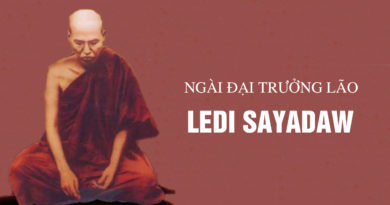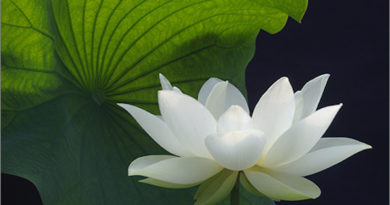A DISCOURSE ON THE ABODE OF THE NOBLE ONES – THE FIVE HINDRANCES
A DISCOURSE ON THE ABODE OF THE NOBLE ONES – THE FIVE HINDRANCES
It is through constant mindfulness that the yogi seeks to remove the five hindrances or nivaaranas, viz. sensuous desire, ill-will, laziness, restlessness and doubt. They block the way to Nibbaana and so their removal is the first Ariyaavaasa dhamma.
Sensuous desire is the desire for pleasant sense-objects such as sights, sounds, smells and so forth. Here the sense-object means not only the object that directly causes pleasant sensation but also other objects that are associated with it. Thus the object of sound refers to a man who speaks persuasively as well as to musical instruments. Smell as a sensuous object is represented by perfumes and human beings who use them. In short, all objects of desire are sensuous objects.
Love of pleasant sense-object is the case of conflict among people and nations. Yet modern man is excessively fond of sensual pleasure and to him it is the summum bonum of life, something that is to be sought by every possible means regardless of all moral considerations. Accroding to the Buddha, sensuous desire is like debt that keeps a man in bondage.
Just as the debtor has to be servile to the creditor, so also a man has to respect the object of his sensual desire. If it is a lifeless object, he must handle it with care and keep it under lock and key. If it is his wife who fuels his sensual desire, he has to avoid doing or saying anything that may displease her.
If you have no desire, it means freedom from worry or anxiety about any desired object or living being. The best way to overcome desire is to watch it constantly. You should focus on it and trace it back to its source. If you thus focus on desire with persistence and strong will, it usually disappears and you are assured of a place in the Ariyan abode.
Those who are outside the Ariyan abode remain attached to sense-objects and sometimes this attachment spells disaster for them after their death. In the time of the Buddha a bhikkhu was so much attached to his robe on his death bed that after his death he became a louse in it. Such a story may be scoffed at by skeptics who argue that a tamarined seed can produce no tree other than a tamarind tree, that gold cannot revert to its former state of earth and that likewise man cannot be reborn as a lower form of life. This argument does not accord with the Buddha’s teaching.
In fact there is no being and life means only the process of consicousness and corporeality. Of these two consciousness is the determining factor. So according to the doctrine of Dependent Origination, because of ignorance there arise karma-formations (sa”nkhaara) which in turn lead to consciousness and so forth. Hence when a new life arises, it is not the corporeality of the previous life or its potency but the force of the consciousness that passes on.
Moreover there is no such thing as big or small consciousness. The mind of an ordinary person does not differ basically from that of an animal. It may revert to a lower state as in case of a man who becomes insane or a victim of rabies. In short, there is no basis for the view that it is impossible for a man to sink to a lower plane of existence after death.
So the pure mind of a dying person imbued with faith, good-will, etc ensures good rebirth whereas the defiled mind full of greed, hatred, etc. leads to the lower worlds. We need not wonder how consciousness manages to reach a far distant place like heaven or hell. Consciousness has no substance and so distance makes no difference to it. Death means the vanishing of the last thought-moment and the emergence of rebirth-consciousness. For the dying person the last state of consciousness is crucial, for if it is unwholesome it may lead to the lower world in spite of his good moral life.
Hence the Buddha’s instruction to the bhikkhus to have the right attitude towards food, robes, and dwellings. They should use them only to meet their physical needs and avoid sensual desire. One may also reflect on the impermanence and emptiness of most sensual objects to overcome attachment to them. But the best thing to do is to watch the arising of desires and reject them.
This instruction is important also for the lay mena and women who have various attachments that are fraught with danger for their afterlife. They can be free from such danger through the practice of Ariyaavaasa dhamma. First they must have faith that is born of sound reasoning and a good knowledge of the Buddha’s teaching. But the Buddha-dhamma insists on the need for empirical investigation as befits its attribute of “ehipassiko – Come and see!” So for the follower of the Buddha practice is of paramount importance.
Most of the bhikkhus around the Buddha attained various stages of enlightenment because they practised Satipa.t.thaana meditation zealously. They never did or said anything unmindfully. Their calm and gentle manners impressed even the wandering medicants who did not follow the Buddha’s teaching. One medicant, Kandaraka by name paid a high tribute to them for their poise and self-possession.
So did his companion, a lay man named Pessa. He appreciated the Buddha’s teaching that had helped reform people who were given to deceit and hypocrisy. But he was so much preoccupied with his worldly affairs that he did not hear the Buddha’s sermon to the end or practise the Dhamma thoroughly. There are other reasons why men like Pessa failed to attain any stage on the holy path. They lack good teachers and a good knowledge of the Dhamma. Association witha bad friend or a bad teacher is disastrous as in the case of prince Ajaatasattu who killed his father at the instigation of his teacher Devadatta.
A good teacher, a good friend and a good knowledge of the Dhamma will make a man realize the need for mindfulness as an antidote to defilements (kilesaa). We must observe and note any sensation that arises from our contact with the external world. We should take note of the bodily sensation that we have when the body, hands, etc. make any movement. We should also be mindful of our mental processes. By taking note to all mental events we can guard ourselves against evil thoughts and emotions.
Although there are ten Ariyaavaasa dhammas mindfulness suffices to ensure the attainment of Nibbaana. In fact, it is the keystone of the Buddha’s teaching. This is clearly borne our by the last saying of the Buddha which may be translated as follows.
“Bhikkhus, here is my last advice to you; All compunded things are subject to disintegration. Work out your own salvation with mindfulness.”
All compounded things (Sa”nkhaara) are impermanent. Many people do not take this fact of life seriously. On the contrary they believe in their personal identity and the permanence of their ego. The average man believes that he can live for a long time with his life-force and body.
“Vaya dhammaa sa”nkhaara appamaadena sampadetha.” Here sakharaa means all the conditioned psycho-physical phenomena; vaya dhamme means that they are by nature subject to decay. Liberation from the phenomenal existence that is conditioned, impermanent, and unsatisfactory means Nibbaana and the way to it lies in the Buddha’s last words: Appamaadena sampaadetha – Practise till you achieve constant mindfulness.
The commentaries describe this advice as the essence of the Buddha’s teaching. It is indeed the keynote of Ariyaavaasa sutta that stresses he far-reaching importance of mindfulness. Through the practice of mindfulness the yogi attains the first stage on the holy path (sotaapanna) where he is free from coarse desire that leads to the lower worlds. At the second stage (anaagaami) he becomes wholly free from the desire for sense-objects. At the last stage (Arahatship) he has done away with all the refined desire for the material and the immaterial worlds.









